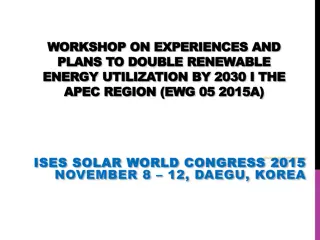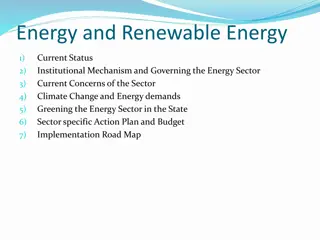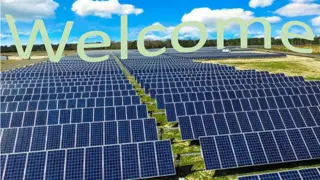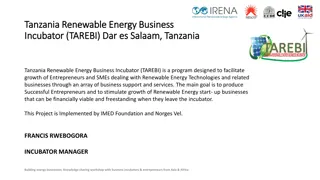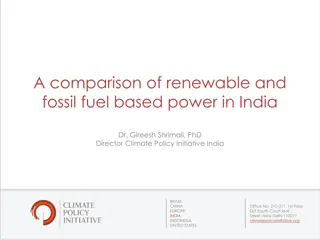Analysis of Renewable Energy and Energy Efficiency Markets in Emerging Economies
Analyzing the development and impact of renewable energy and energy efficiency markets in emerging economies such as China, Turkey, India, Brazil, South Africa. Focus on employment effects, policy instruments, market growth, and strategies in place.
Download Presentation

Please find below an Image/Link to download the presentation.
The content on the website is provided AS IS for your information and personal use only. It may not be sold, licensed, or shared on other websites without obtaining consent from the author. Download presentation by click this link. If you encounter any issues during the download, it is possible that the publisher has removed the file from their server.
E N D
Presentation Transcript
Good practice analysis: Analytical framework and first results Klaus Jacob, Holger B r Environmental Policy Research Centre Tunis, GIZ SE4JOBS Workshop, June 9th, 2015
Developing RE and EE Markets Private sector supplying RE and EE technologies Demand for RE /EE Policies to enable markets and employment: - Supply side instruments: Innovation and investments, training - Demand creating instruments, - Policies for infrastructures and market mechanisms Policy mix and policy integration Strategies + Strategic process
Goals Analysis of good practice countries regarding: - Markets for technologies for renewable energy and energy efficiency - Domestic creation of value - Employment - Strategies and policy instruments Evidence for causalities Analysis of transferability -necessary framework conditions for successful approaches
Selection of good practice countries Criteria for selection of countries: Emerging economy Markets for RE or EE technologies - Installed capacity of RE technologies and capacity under construction - pace of market growth in these markets & project pipelines - Energy intensity of industry Or: Employment in RE / EE - However: Lack and often poor quality of data Or: Strategies in place Turkey, India, China, Mexico, South Africa, Brazil
Estimated employment effects until today China: 350.000 Jobs in wind energy, 1.6 Mio jobs in PV, Turkey: 81.000 Jobs in wind energy Brazil: 32.000 Jobs in wind energy, 30.000 in solar water & heating, 12.000 in small-scale hydropower India: 110.000 jobs in PV South Africa: 15.000 jobs in PV, 3600 jobs in wind energy Lack of data on energy efficiency markets and in other fields and countries
Analysis of good practice countries What is the outcome? - E.g. development of RE capacities and employment over time What are the systemic conditions? - E.g. Natural conditions, political system, financial system, socio-demographic situation What strategies are in place? - E.g. Goals, horizontal and vertical coordination, participation, work program, capacities, evaluation and monitoring What policy instruments have been adopted? - Supply, demand and market mechanisms including framework conditions What is the outlook? - Expected development of markets & local employment
Example of South Africa Why is SA a good practice case: - Installed capacity relatively small, but enormous amount of capacity under construction under the REI4P system
Why is South Africa a Good Practice? Installed wind and PV capacity in South Africa, in MW Employment: Wind: 3600 (SA government 2012) Solar (PV+CSP): 15.400 +1.900 (SA government 2012)
South Africa Why is SA a good practice case: - Installed capacity is small, but enormous amount of capacity under construction under the REI4P system Framework conditions - Banking and finance system & fast rise in electricity prices Strategies - IRP as living strategy with extensive public participation Policy instruments - Auction scheme with local content requirements
South Africa Why is SA a good practice case: - Installed capacity is small, but enormous amount of capacity under construction under the REI4P system Framework conditions - Banking and finance system & fast rise in electricity prices Strategies - IRP as living strategy with extensive public participation Policy instruments - Auction scheme with local content requirements Outlook: - High expected growth in electricity demand (5,4% p.a. till 2030); RE very soon competitive with investments in fossil energies; estimated nearly half a million green jobs by 2025, 80.000 of which in RE, 68.000 in EE
Frequent observations across cases Co-Evolution of policies, technologies and private sector Importance of - Human capacities - Technological capacities - Supporting local business and trade - Financing - Participation in strategy development and implementation - Coordination within government - Access to grid Strategic and comprehensive approach needed
Structure of the tool kit: Strategy cycle 1. Assessment 2. Co- benefits 10. Markets 3. Trade- offs 9. 11. Demand Monitoring & Evaluation 4. 8. Goals Supply 5. Responsibilities 7. Participation 6. Coordination
Issue Supply: Human Resources Supply of RE/EE technologies requires skilled human resources How should training and capacity development RE & EE jobs be provided? Options: - Integration into existing scientific & training programs at universities, the normal vocational training vocational system: TR, CN - Establishing RE/EE specific institutions and centres: SA, IN, BRA (particularly in context of GIZ development cooperation)












